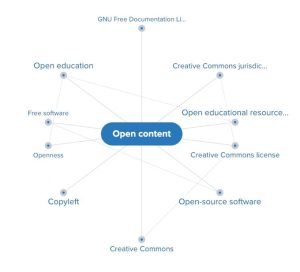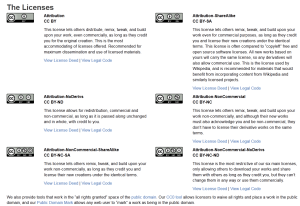Open Licensing and Creative Commons Licenses for Publishing
Tara Spies Smith
Learning Objectives
- Understand what Creative Commons licenses are
- Learn about public domain and other types of openly licensed creative content
- Learn how to find Creative Commons content and other openly licensed creative content
- Learn how to read the licenses
Creative Commons Licenses
“Creative Commons licenses give everyone from individual creators to large institutions a standardized way to grant the public permission to use their creative work under copyright law. From the reuser’s perspective, the presence of a Creative Commons license on a copyrighted work answers the question, “What can I do with this work?””
Definition by CreativeCommons.org is licensed under a Creative Commons Attribution 4.0 International license.
Watch the What is Creative Commons? video to learn more and be inspired with what you can do with Creative Commons licensed content:
The content contained in this video is available under the Creative Commons Attribution- ShareAlike License v 3.0 unless otherwise stated. The work is attributable to: Victor Grigas, Wikimedia Foundation.
Public Domain
A work that is in the public domain is a work that is out of copyright and free to use. Works in the public domain may not need to be cited or given attribution, but the ethical thing to do is to cite and give attribution to another’s work. “Information that is unrestricted and accessible by the general public – program which is in the public domain a program which is not copyrighted” - public domain. (2006). In P. H. Collin (Ed.), Dictionary of publishing and printing (3rd ed.). A&C Black. Credo Reference: http://libproxy.txstate.edu/login?url=https://search.credoreference.com/content/entry/acbpublishing/public_domain/0?institutionId=1143
See examples of work that are in the Public Domain that you can use at some of the cultural institutions and websites on the Openly Licensed & Copyrighted Creative Content For Your Scholarly Works guide
Getty Search Gateway or Getty Open Content Program
Other Types of Open Content
“Open content is typically digital content that allows broader use than traditionally printed or copyrighted content. Open content is freed up content, for instance through permissive licensing, such as Creative Commons.” – Haßler, B., & Mays, T. (2015). Open content. In R. Mansell, & P. H. Ang (Eds.), The international encyclopedia of Digital Communication and Society. Wiley. Credo Reference
Openly licensed images or other creative content that have alternative terms to copyright can be used freely as long as any terms given are followed, for example Creative Commons licensed content.

The 6 Different Creative Commons Licenses and What They Mean

Diving Deeper
Creative Commons licenses provide an easy way to manage the copyright terms that attach automatically to all creative material under copyright. The licenses allow that material to be shared and reused under terms that are flexible and legally sound. Creative Commons offers a core suite of six copyright licenses. - https://creativecommons.org/faq/#what-are-creative-commons-licenses
The public domain of copyright refers to the aggregate of those works that are not restricted by copyright within a given jurisdiction. A work may be part of the public domain because the applicable term of copyright has expired, because the rights holder surrendered copyright in the work with a tool like CC0, or because the work did not meet the applicable standards for copyrightability. - https://creativecommons.org/faq/#what-is-the-public-domain
An open license is one that grants permission to access, re-use and redistribute a work with few or no restrictions (definition from Openedefinition.org). - https://libguides.csudh.edu/c.php?g=679215&p=7626572
Creative Commons is a global nonprofit organization that enables sharing and reuse of creativity and knowledge through the provision of free legal tools. - https://creativecommons.org/faq/#what-is-creative-commons-and-what-do-you-do
"Copyright law grants exclusive rights to creators of original works of authorship. National laws usually extend protections to such works automatically once fixed in a tangible medium, prohibiting the making of copies without the rights holder’s permission, among other things." Read more: https://creativecommons.org/faq/#what-is-copyright-and-why-does-it-matter
to give credit or attribution to a creative work or idea. Attribution vs. Citation from the Gettysburg College Digital Humanities Toolkit. https://dh.sites.gettysburg.edu/toolkit/media/attribution/
“Open content is typically digital content that allows broader use than traditionally printed or copyrighted content. Open content is freed up content, for instance through permissive licensing, such as Creative Commons.” – Haßler, B., & Mays, T. (2015). Open content. In R. Mansell, & P. H. Ang (Eds.), The international encyclopedia of Digital Communication and Society. Wiley. Credo Reference: http://libproxy.txstate.edu/login?url=https://search.credoreference.com/content/entry/wileydcas/open_content/0?institutionId=1143
"This license enables reusers to distribute, remix, adapt, and build upon the material in any medium or format, so long as attribution is given to the creator. The license allows for commercial use." - https://creativecommons.org/share-your-work/cclicenses/
This license enables reusers to distribute, remix, adapt, and build upon the material in any medium or format, so long as attribution is given to the creator. The license allows for commercial use. If you remix, adapt, or build upon the material, you must license the modified material under identical terms. - https://creativecommons.org/share-your-work/cclicenses/
This license enables reusers to distribute, remix, adapt, and build upon the material in any medium or format for noncommercial purposes only, and only so long as attribution is given to the creator. - https://creativecommons.org/share-your-work/cclicenses/
This license enables reusers to distribute, remix, adapt, and build upon the material in any medium or format for noncommercial purposes only, and only so long as attribution is given to the creator. If you remix, adapt, or build upon the material, you must license the modified material under identical terms. - https://creativecommons.org/share-your-work/cclicenses/
This license enables reusers to copy and distribute the material in any medium or format in unadapted form only, and only so long as attribution is given to the creator. - https://creativecommons.org/share-your-work/cclicenses/
This license enables reusers to copy and distribute the material in any medium or format in unadapted form only, for noncommercial purposes only, and only so long as attribution is given to the creator. - https://creativecommons.org/share-your-work/cclicenses/

